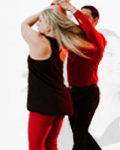For followers, accenting the 1 of the musical phrase is more challenging than for the leaders because you don’t get to pick the pattern that is being led. As a result, you need to have options to accent the 1 at any point within a pattern. In this article we will help you!
The good news is that you don’t have to do any math while you’re dancing to figure out how long you have until the accent occurs; as long as you can identify the 1 of the music, you don’t need to calculate how many beats away you are like the leaders do.
Need to find the ‘1’ in the music? Download> The #1 Key to WCS Musicality
Here is your drill
With or without a partner, practice dancing side passes to a song that has a clear accent on the 1, like Fill Me In, Pt. 2 by Craig David. Begin by dancing the side pass starting with the 7 of the phrase, and note where you are in the side pass (it should be count 3). Pick some styling option that you like in order to accent that count. As a “starter kit” for follower accents, try out the following options:
- Tilt your head
- Drop a shoulder
- Do a chest pop
- Isolate your ribcage to the side
- Push the free arm out
- Throw a hip to the side
- Syncopate your footwork to accent the downbeat
- Add a level change
Need some styling ideas? Get our WCS Styling Checklist
After you dance the accent, reset for the next 7 of the music. If you miss the 7 because you or your partner aren’t in position, wait until the next 7 rather than rushing to catch up. The point of this drill is to teach your subconscious how to style a side pass when you start on beat 7; practicing a different timing will negate the value of the exercise.
Once you find an option that is comfortable, watch in a mirror or video tape yourself to make sure that the movement looks good. Keep practicing that movement until it becomes second nature when you are led in a side pass beginning on count 7.
Next Drill
Repeat this exercise but start the side pass on beats 1, 3, or 5 of the phrase. The “start on 1” option is especially important because at that point your leader has missed the accent and can’t set you up. If you can create something out of that situation, it will dramatically improve the musicality of your partnership.
Once you are comfortable with all the times that you could start a side pass, extend the drill to your other basics. Your eventual goal is to have the ability to accent any downbeat within any pattern.
Watch our video “Accenting the 1 in the Music”
My #1 Musicality tip
Did you miss the video download above? If you did, you’ll want to get it here! Of all things related to musicality I think that “counting straight 8’s” is the first really big key to unlocking musicality. Thats why I call it my #1 Tip. You can get the video here…

But wait there is more….Lots more!
There are SO MANY things that can go into mastering musicality in WCS.
- Counting the music
- Keeping time to the music
- Critical Timing
- Critical Accents
- Counting Straight 8’s
- Mapping the music
- Contemporary & Blues music phrasing
- Understanding the build in the music
- 4 Ways to accent the music
- Extending patterns to hit accents
- Rolling count
Because of that we have created the “Ultimate Guide to Musically for WCS.” Because it contains 14 videos, 6 PDF’s and a BOUNUS 1 hour live video of our musicality class it’s priced at $149. For a short time you can get it for a 54% discount with this link>> Ultimate Guide to MusicalityI hope you guys enjoy. Happy dancing! -Brian B





 Brian & Megan
Brian & Megan